Special to Transport Topics
Fleets Must Decide on Buy vs. Lease, When to Sell, Among Other Choices
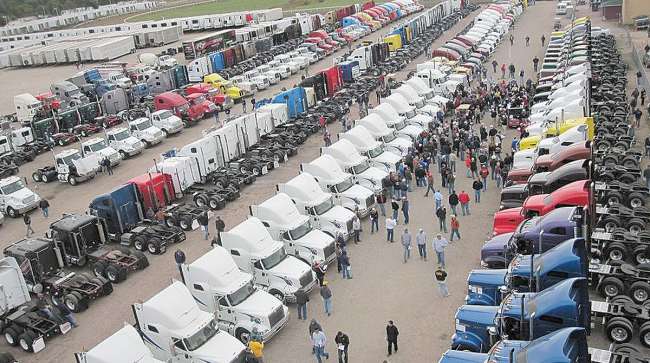
[Stay on top of transportation news: Get TTNews in your inbox.]
How fleets buy, maintain and sell their assets has never been more pivotal than in today’s shifting business landscape.
Buy or lease? Outsource maintenance or do it in-house? What’s an acceptable maintenance run rate? When is a truck too old? When’s the best time to sell? Should a fleet send a used truck to auction or sell on its own? How does a fleet keep equipment current with the latest technology? And how does a fleet stay on top of driver wants and needs to keep them happy and on the team?
Whether it’s capital acquisition plans for new equipment, effective maintenance to extend useful life or disposing of used assets at the best time and place, these fundamental business planning, operations and asset management activities must be aligned and integrated for trucking fleets, industry experts said.
The cost of a Class 8 tractor can easily exceed $125,000. Every year, manufacturers introduce new models with improved safety, emissions control, driver assist and comfort, fuel-saving and other features. The technologies with which trucks operate today are sophisticated and integrated, requiring technicians skilled as much, if not more so, in computers and diagnostics as they are at turning a wrench.
Fleets want every tool and trick they can find to increase fuel economy. Shippers are more environmentally conscious and want fleets to be as “green” as possible. Government regulations continue to evolve for emissions and safety.
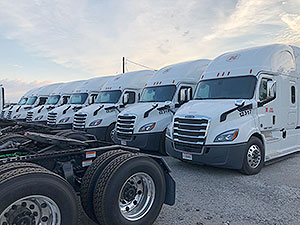
New trucks lined up at Hub Group Trucking's Chicago terminal. (Hub Group Trucking)
Hub Group Trucking follows five guiding principles for its fleet acquisition, trade cycle and disposal strategies, said John Vesco, executive vice president. They are: safety and reliability, driver appeal, deploying the latest technology, fuel efficiency and total cost of ownership.
“Safety is first and foremost,” Vesco said, noting that having newer equipment supports that. The company also wants to ensure its trucks are attractive from a driver perspective, with the latest features, comforts and technologies, as well as reliability.
A detailed and well-thought-out capital expenditure plan — and disposal strategy — that covers all aspects of fleet needs and operating considerations, are table stakes, according to Mike Britt, principal of Beverly Hills, Fla.-based MG Britt Consulting. Prior to launching his own firm, Britt spent about 30 years with UPS retiring in 2017 as senior director of maintenance and engineering.
“The best strategy is to establish a ‘continuous build’ [plan]. This will help the vehicle manufacturer remain consistent with quality, materials and skill sets,” he said, adding that fleets should plan for a rolling schedule of new equipment deliveries spread evenly throughout over the year, tightly aligned and timed with retiring old equipment. “This process will reduce maintenance cost on vehicles ready to retire, keep quality on new builds and prevent ‘full fleet’ out-of-service situations,” he said, adding that it will keep a fleet’s workforce “from being bombarded with loads of new equipment to learn all at one time.”
Britt also recommends that fleets establish duty cycles for equipment at every stage of life. “The warranty period must be fully utilized so new equipment is running as much as possible,” he said. After that, older equipment should be used less to reduce excessive maintenance expense.
“Some states have incentives [for retiring] old equipment and replacing with [new trucks] that have the latest emission control systems,” he added, noting the incentives can be as much as $25,000.
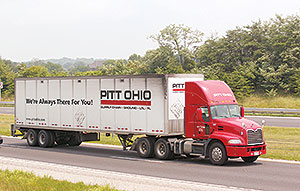
As a disposal strategy, Pitt Ohio relies on auctions, a company executive says. (John Sommers II for Transport Topics)
Taki Darakos, vice president of vehicle maintenance and fleet services at Pittsburgh-based Pitt Ohio, emphasized balance and managing fleet composition for current and projected business plans and life cycle maintenance costs to achieve maximum return on investment, and asset use. Pitt Ohio has a fleet of 2,000 tractors and 5,200 trailers, among other vehicles.
Darakos noted that spec’ing trucks for LTL service is different than for truckload; both have specific operating demands and characteristics unique to the needs of their markets — and their respective truck drivers. The strategies “are tailored for the operating and driver environment, maintenance and trade cycles,” he noted.
A typical LTL tractor, spec’d as a “day cab,” might operate for as many as 10 years and accumulate as much as 1 million miles before being retired.
A TL tractor, by contrast, deployed almost exclusively in longhaul, irregular route service, might collect 100,000 miles a year, and operate over a four-year trade cycle before being retired and sold into the used truck market.
For TL use, engine, drivetrain and drive axle configurations are far different from LTL. In addition, for the TL driver, the truck is his or her home and office, so the interior cab design and specifications are entirely different — and more luxurious — than LTL. The TL tractor also is typically equipped with an integrated sleeper unit; both cab and sleeper are appointed with amenities, lifestyle comforts, options and livability features for drivers.
The acquisition and disposal cycle also must consider evolving technology, Darakos noted. It’s a balance between getting the most value and utility out of the life of the asset, versus holding on to it too long to the point at which maintenance costs exceed boundaries, and its technology reaches obsolescence.
“Drivers want the newest trucks with the newest features and equipment,” he said. It’s “more attractive” and helps with driver retention and recruiting as well as lowers operating costs.
Pitt Ohio purchases its equipment and doesn’t do leases. Darakos stressed that it’s important to have a good mix of new, middle-aged and older units maturing through the fleet on a life cycle timeline that’s as balanced as possible. By doing this, fleets avoid spikes and unanticipated upswings in the cost of trucks, engines and components; ensure a predicable run-rate of maintenance expense; and, ensure optimal fleet uptime and minimal service disruption from breakdowns.
“When you have a good mix, your [capital expenditure] becomes more predictable and you benefit from an even approach to maintenance expense,” he said. “You can plan and manage it more accurately, drive consistency in fleet utility and lowest-cost operating expense and keep your drivers happy with high fleet uptime and trucks that have the latest driver-assist technologies.”
Lastly, as a disposal strategy, Pitt Ohio relies on auctions. The company is not a wholesale truck sales operation, he said.
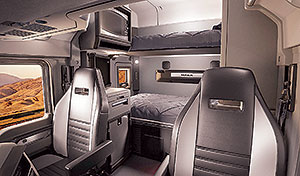
A Mack truck cab with ergonomic features. Such features attract drivers, experts say. (Mack Trucks)
Hub Group, meanwhile, is somewhat unique in that it plans and specs trucks — and their usability life cycle — for double-duty supporting intermodal drayage operations and dedicated fleet activity. The other two legs of Hub’s “big three” asset mix are dry-van trailers and a fleet of intermodal rail containers.
With both dedicated over-the-road trucking and intermodal drayage operations, Hub specs tractors to be interchangeable among them. “Transferability helps us with deployment strategy,” and having resources available in the right place at the right time, said Vesco. That gives operations the flexibility to interchange power units among the two businesses as volumes surge in one or the other or, for example, specific customer needs for dedicated capacity arise.
Hub Group does not engage in leases, opting to purchase and own its equipment. That allows the company to take advantage of accelerated depreciation, which helps cash flow, he noted.
Like other operators, Vesco cited an aggressive and comprehensive preventive maintenance program as fundamental to achieving lowest-cost operations. “If we see an asset aging faster due to work type [or extraordinarily heavy use] we accelerate the trade cycle.”
While asset ownership has its advantages, equipment leasing also can be a viable strategy that delivers its own benefits as an asset acquisition and disposal strategy, said Brian Holland, president of Fleet Advantage, which provides leasing and truck life cycle management services. There are several different considerations and end goals that can influence a strategy for capital expenditures, Holland said, “but I’d start by saying that regardless of what those are, we believe it is imperative to have a plan and a systematic asset management strategy for the fleet. Understanding long-term goals and how that impacts strategy is essential.”
Most of his business is with private fleets, which tend to be focused on customer service. Yet “there are a lot of fundamentals that apply to both [private and for-hire fleets],” he said.
Holland’s firm focuses more on shorter life cycle strategies and the advantages these can present for private fleets. “We look at cost of ownership compared to leasing, also short compared to longer life cycles,” he noted. And while there are certain asset classes where ownership may make more sense, “depending on the specific duty cycle and asset, and what the objectives are, we believe that leasing provides a great deal of flexibility that drives significant savings,” he noted.
Fleet Advantage regularly publishes data that compares cost savings of four-year lease cycles, versus a seven- or eight-year purchase cycle. “Savings over that time period can be $20,000 to $30,000 per unit,” Holland noted. Overall, Holland believes that leasing provides a tax-friendly option that makes for easy equipment acquisition and disposal and a clear line of sight into a consistent cost run-rate.
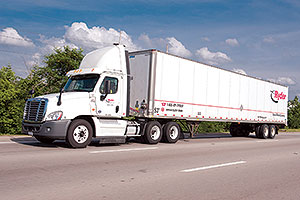
Longer-term financing is generally the best strategy where business volumes are stable over time, a Ryder executive says. (Ryder System Inc.)
As a rule, longer-term financing is generally the best strategy where business volumes are stable over time, noted Kevin Sheedy, Ryder director of sales operations for Fleet Management Solutions, one of the nation’s largest fleet management, logistics and supply chain services providers. “A long-term lease or purchase strategy will result in lower overall costs,” in this scenario, he noted. However, a business that’s exposed to recurring, highly cyclical swings or seasonal spikes might want to consider supplementing the base fleet with short-term leases or rentals.
“Short-term costs will be higher, but what you are really doing is buying flexibility to manage volatility,” he said.
CapEx and disposal plans and strategies eventually become a question of risk tolerance. “It’s recognizing the reality of risk and the variables. Am I OK with tolerating this degree of risk in my operating strategy? Or should I consider [more] alternatives that would mitigate these risks?” Sheedy noted.
What’s the best long-term strategy? “Consistency. Don’t overreact to market swings,” added Robert Ragan, executive vice president and chief financial officer of Tulsa, Okla.-based Melton Truck Lines. Ragan serves on the board of the National Accounting and Finance Council of American Trucking Associations.
He follows several fundamental best practices. Understand your operating environment, business needs and growth plans, and spec equipment to meet those criteria. Invest in preventive maintenance. Trade or sell the unit before the warranty expires. And understand the total cost of ownership.
“Know what you paid for it, what you spent [on it] while you owned it, and what you sell it for,” said Ragan, adding that if you take care of the equipment while you own it, “you’ll have a good reputation in the market that will maximize the residual value of your rolling stock when you sell.”
Want more news? Listen to today's daily briefing:


